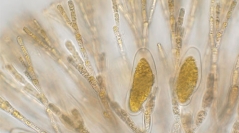

 Cryptogamie, Algologie
27 (1) - Pages 03-15
Cryptogamie, Algologie
27 (1) - Pages 03-15The spongy, crustose brown alga Petrospongium rugosum (Okamura) Setchell et Gardner occurs in Korea, Japan, Australia, New Zealand, and along the Pacific coast of North America. Although the species has been classified in the Chordariaceae of the Ectocarpales sensu lato or the family Leathesiaceae of the Chordariales sensu stricto, the relationship of the species to other brown algal lineages is less studied in terms of the plastid ultrastructure and molecular phylogeny. We examined the morphology of P. rugosum and also determined protein-coding psaA and rbcL sequences from four samples of the species from different locations, comparing them with homologous positions of newly sequenced putative relatives (Leathesia difformis and Spermatochnus paradoxus) and with published sequences of other brown algae. The species occurs in the upper intertidal zone on the Korean south coast from November to June. Thalli are markedly rugose and are comprised of haplostichous filaments, arranged into cortical and medullary layers. Unilocular sporangia arise laterally on the lower cells of cortical layers. A large pedunculate pyrenoid, with a cap, is present in the parietal discoid plastids. The specimens from four different locations were almost identical in rbcL and psaA sequences, and were monophyletic. All phylogenetic analyses of both genes reveal that P. rugosum is clearly separated from Leathesia and other members of the Chordariaceae. The sister relationship of the species to Ectocarpus was not supported by bootstrap or Bayesian analyses.